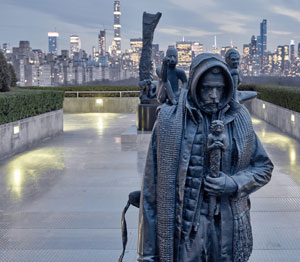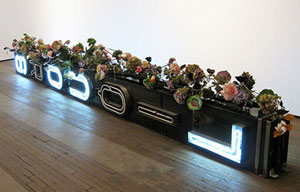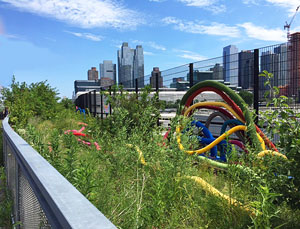The Feast of Summer
John Haberin New York City
Summer Sculpture 2017
Anish Kapoor, Adrián Villar Rojas, and Nari Ward
On a hot summer day, New Yorkers might wish they had a backyard swimming pool—if only they had a backyard apart from the city's parks. And there, in Brooklyn Bridge Park, Anish Kapoor sets out a pool for anything but wading. In place of his usual sweeping curves, it has a whirlpool at its center, sucking water in and churning the water up at its edges.
Nestled almost beneath the bridge, it exists between the Scylla of gentrification and the Charybdis of art. Fortunately, it looks more meditative than threatening, and its title, Declension, sounds more out of Latin grammar than Greek myth.  It could evoke a gentler slope as well, toward the East River and sea. Of course, in grammar a declension means running down nouns and adjectives, so how about a run through more of a New Yorker's backyard—and 2017 summer sculpture? Start on the Met roof with Adrián Villar Rojas and a stiff drink, detour to Socrates Sculpture Park for Nari Ward and a herd of goats, and return to Manhattan for the grand boulevards, the High Line, and quieter parks. Together, they offer the feast of a New York summer.
It could evoke a gentler slope as well, toward the East River and sea. Of course, in grammar a declension means running down nouns and adjectives, so how about a run through more of a New Yorker's backyard—and 2017 summer sculpture? Start on the Met roof with Adrián Villar Rojas and a stiff drink, detour to Socrates Sculpture Park for Nari Ward and a herd of goats, and return to Manhattan for the grand boulevards, the High Line, and quieter parks. Together, they offer the feast of a New York summer.
A banquet of antiquities
The roof garden of the Met is set for a feast, but do not expect to dig right in. Oh, drinks and light snacks are still for sale, for those long summer evenings with views of the park. Banquet tables are there as well, with enviable place settings. Still, everything has the same ghostly white, from overturned goblets to mismatched knives. Coins lie strewn across one table, like mints or crackers—but with a sleeping child in place of dessert or a dip. Other tables bear restless, dead, or sleeping bodies.
Besides, this is art, with clear directions not to touch, much less to dine. Pierre Huyghe changed little in 2015, beyond a few floor tiles, while Roxy Paine filled the roof with a forest after a storm some years before. This year's summer sculpture offers a treacherous compromise, as "The Theater of Disappearance." Adrián Villar Rojas leaves room to wander, while undermining hopes of where to sit. His checkerboard flooring rises up to form two short benches, but also a barrier on the way to the bar. He sets standing sculpture in black, like guards distracted by stories of their own.
Already at age thirty-seven, Villar Rojas has a habit of raising obstacles. He set a concrete box on the High Line in 2015, as The Evolution of God, and he directed a dark restaging of MoMA PS1 in 2013, as The Innocence of Animals. He has animals and gods here, too, all of them from the Met's collections. He selected nearly a hundred objects, in conversation with the museum's curators, for a theater of repeat appearances. He then combined scans of the antiquities with scans of live people to produce his seventeen sculptures. He also took charge of the tiling and planting, with twisted vines that fit right in with the twisted bodies and twisted narratives.
The dialogue extends from the artist and curators to the visitor. It just happens to lack subtitles. Turning the corner from the entrance, you might mistake additional wall text for a list of source material, but nope: it is the bar menu. It would take a smarter critic than I to name much more. The museum goes too far in calling this a critique of collecting practices, but it is still a feast for historians.
That feast belies a genuine melancholy—for much of the art began in commemoration of the dead. An Arthurian hero from the face of a tomb has a second sword as a pillow and a young man by his side, lending him a maternal side and an uneasy new life. A man stares at an empty plate in search of his image or a meal. A kneeling soldier could be constructing a statue of lovers or separating them. A man with African figurines on his shoulders, a body in his backpack, and the bent head of a homeless person stands guard over the southern end of the terrace, where the checkerboard gives way to metallic flooring. Judging by the Met's photo of Villar Rojas, the figure's pose and hoodie match the artist's.
One can tire quickly of art's bad boys, like Maurizio Cattelan or Paul McCarthy. One can tire, too, of the drive to anoint the next superstar with a 3D printer and the cutes. A figure with hunting horns for a hat and wild animals for shoulder pads may sound cringe inducing at that. Credit Villar Rojas, though, with a creative dialogue. A woman sleeps beside an alert cat, while a sleeping boy holds a horse's head like a scene out of The Godfather. Meanwhile the visitor stares at the work of seven continents—and a living Argentine.
Getting one's goat
Nari Ward can really get one's goat. In fact, he can get about a dozen of them, scattered across Socrates Sculpture Park as if in search of dinner. None of them look all that frisky, as goats go, perhaps because they lack for grass in a park eternally in need of a new lawn. They bear a heavy burden as well. They carry everything from rough metal spikes to tar and feathers. They could be giving off energy or the victims of a lynching.
As for meaning, too, Ward can get one's goat. He keeps returning to the theme of role models for young black men. He sought a dialogue with the cops on video, as Fathers and Sons, and displayed burnt oil drums as anything but a call to violence at the 2006 Biennial. Yet he plays the bad boy quite as well as macho white artists, maybe more than ever in the comfort of summer sculpture. He may have no other choice if he wishes to explore the pressures of mass culture without blaming the victim. Besides, artists are supposed to get on one's nerves.
Ward is on familiar grounds, starting with the work's title, G.O.A.T., again. He means not just his past, but that of others as well. The acronym stands for "greatest of all time," as with Muhammed Ali and LL Cool J, and Ward is not dismissing their physical and verbal wizardry—or their pride in African American identity. He does, though, raise challenges. A huge jump rope on the Broadway billboard has the coarseness of knotted fiber, with King imprinted on its handles. It might celebrate a formidable training routine, or it could be reducing culture heroes to overgrown children.
 Not that child's play is unhealthy, especially in art. And Ward, too, is entitled to boast, with the park's first solo show. He boasts of black culture again with a riff on the marquee of the Apollo Theater in Harlem, much like his riff on a liquor store in "Uptown" at the Wallach Gallery. Its blinking letters POLL suggest the need for action where it counts, at the polls. Elsewhere a green mass hangs from a supporting frame like a bell, but in the shape of goat gonads. Both its resonance and its virility have suffered from serious oxidation.
Not that child's play is unhealthy, especially in art. And Ward, too, is entitled to boast, with the park's first solo show. He boasts of black culture again with a riff on the marquee of the Apollo Theater in Harlem, much like his riff on a liquor store in "Uptown" at the Wallach Gallery. Its blinking letters POLL suggest the need for action where it counts, at the polls. Elsewhere a green mass hangs from a supporting frame like a bell, but in the shape of goat gonads. Both its resonance and its virility have suffered from serious oxidation.
At forty feet, the show's largest work boasts as well, while attesting to a boast that failed. One more goat head lies at the end of a concrete pole, like the fallen idol of a dead culture—or like the "shattered visage" in "Ozymandias," by Percy Bysshe Shelley. As the poem goes, "Look on my work, ye mighty, and despair." Like Shelley, Ward is enough of an ironist to take those words to heart. The mighty may despair because they will never rise so high—or because they, too, in time must fall so low. Ward got out of the way just in time.
Still, he brings the fall into the realm of play and into the present. A black chandelier hands within a circular shed, like the disco light that failed. And the pole ends with a big wheel, and a handle runs through the goat's head. Someone might have been using it as a unicycle before falling. In Shelley's poem, the head has fallen on a wasteland, where "nothing beside remains." This head is in a park in Queens, where people walk their dogs and come for summer movies—for now, surrounded by a herd of goats.
Burying summer
Anish Kapoor is not the only sculptor evading death. Lluis Lleo raises sandstone slabs along Park Avenue, like burial steles for Minimalism. If the graves lie empty, blame it on zombie formalism. One side of each stone has an overlay in color, the other a second color with the very same geometric shape cut out from it, as a display of positive and negative space. You get to decide which is which, but watch out. Summer sculpture in Manhattan has more than enough positive and negative vibes to go around.
Not to be outdone, Joy Brown brings nearly five miles of sculpture to Broadway—but with just nine clay pieces. Think of them as official greeters to subway stations from the Upper West Side deep into Harlem. Not even I can claim to have seen them all, but Brown has sure spread a lot of conviviality. Each has the mass of Fernando Botero, the childlike smirks of anime, and the rounded outlines of both. With heads in hands or as parents with children, they all but cry out adorable. They made me grateful to catch the ride home.
Back in Rockefeller Center, Jeff Koons means his forty-five foot Seated Ballerina to honor National Children's Month. It does better at calling attention to America's enduring love of kitsch and, more to the point, Koons himself. Up by Central Park, Liz Glynn leaves out gray concrete arches and chairs, as Open House. She models them after the ornate interior of a Fifth Avenue mansion, designed by Sanford White. The rigid seating plays out against the mansion's disappearance into history, the arches against the great outdoors. No one seemed to worry, though, about either the layers of meaning or the discomfort— not when seating comes in handy at lunch.
not when seating comes in handy at lunch.
The High Line calls its summer show "Mutations," but much of it is static and lifeless. Dora Budor does say that her white blobs change color when wet, but pardon me if I do not venture up in the rain to find out. And Veit Laurent Lurz says that a craggy stone fountain flows with the "herbal juice of the future," but pardon me if I hold off until then. Henry Taylor looks down on them all from a mural, but if only he could see Sheila Hicks half a mile north after a late start—although she lingers on a bit into 2018 summer sculpture as well. Her colorful tubes lie poised against rusted inaccessible railings and lurk in weeds. Hudson Yards may not welcome more than luxury real-estate, but it can still run warm and wild.
Josiah McElheny treats Madison Square Park to sets for music, dance, and poetry, but I prefer to see them as elements of architecture. His sea-green floor never quite settles into the grass—or a perfect circle. For a ceiling, he has a red and yellow arch, facing the deep blue curve of a wall. McElheny achieves his colors with painted wood broken by circles of prismatic glass. They have their own territory in the lawn, fenced off from sunbathers. With luck, they will never settle into a structure that keeps out the summer sky—and, before you know it, a grid of lights by Erwin Redl will have settled in for winter.
Katja Novitskova, an Estonian, looks for the complexity of life on two scales, one more intoxicating than the next. Her aluminum disks in City Hall Park take on the rotundity and fertility of the earth or, she imagines, distant moons—but with an overlay of microorganisms, human cells, and marine biology. So is New York for the summer a pool party, a banquet for the senses, a graveyard, or a laboratory? If you have to ask, you have missed the depth of its history and the diversity of its pleasures. The Governors Island Art Fair holds off until Labor Day. I shall let you know more.

Anish Kapoor ran in Brooklyn Bridge Park through September 10, 2017, Adrián Villar Rojas at The Metropolitan Museum of Art through October 29, Nari Ward in Socrates Sculpture Park through September 4, Joy Brown along the Broadway Mall through November 30, Liz Glynn near Grand Army Plaza through September 4, Josiah McElheny in Madison Square Park through October 8, and Katja Novitskova in City Hall Park through November 9. High Line art continues into March 2018. A related review follows 2017 summer sculpture to Storm King for David Smith in white. I continue to follow summer sculpture as in 2019 summer sculpture, 2020 summer sculpture and its extension into fall, summer 2021, summer 2022, summer 2023, summer 2024, and past years going back to summer 2003 and last year to Rockaway Beach. Another related review looks at Nari Ward in retrospective.




